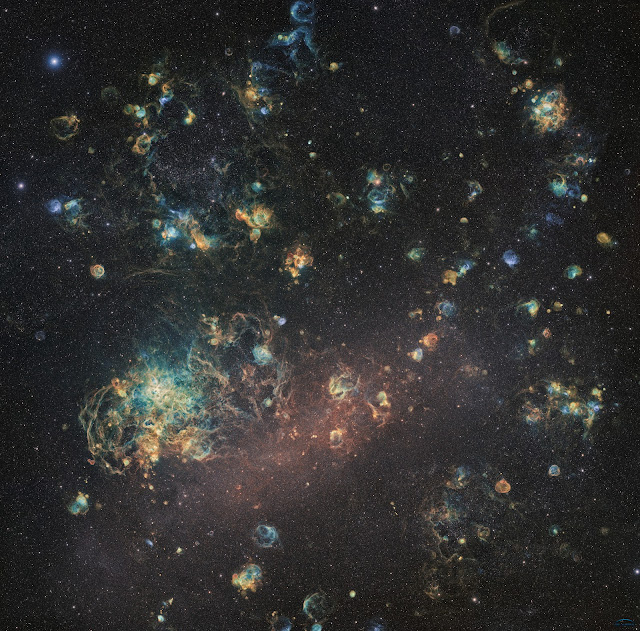1060 is the number of hours needed to capture this highly-resolved image (204 Megapixels) of the Large Magellanic Cloud. It might be the world's longest exposure image within the amateur astronomers community.
In astrophotography, the amount of time you spend imaging a celestial object is inherently fundamental. The longer your camera's shutter is open, the more light you get, so that the darkest regions of the sky start to get clearer. Usually, amateur astronomers are familiar with very long integration times, such as few minutes or even few tens of hours. However, reaching a total amount of several hundred hours increases the complexity of image processing and therefore remains quite rare... though, five keen amateur astrophotographers challenged themselves and decided to capture a picture of 1060 hours of total exposure time, which can be considered as a world record (professional astronomy excluded).
This image is not only a technical accomplishment, but brings also a scientific interest to one of the most amazing deep sky object of the Southern sky : The Large Magellanic Cloud (LMC).
 |
| P1060-hour-exposure in the Large Magellanic Cloud, in SHO colors. Taken by "Ciel Austral". |
★ A Team of amateur astronomers behind this feat
The image is a mosaic made of 16 smaller fields of view, which, once stitched together form a high-resolution image of 204 Million of pixels! As of matter of fact, this is not the work of a single person but by a team of five french amateur astronomers called "Ciel Austral": Jean Claude CANONNE, Philippe BERNHARD, Didier CHAPLAIN, Nicolas OUTTERS et Laurent BOURGON.
"Ciel Austral" owns a remotely-controlled observatory located in the most prestigious skies of the planet, in Chile, and more precisely at the El Sauce Observatory (Coquimbo Region). A 160-mm APO-refractor telescope and a Moravian CCD were used to obtain this wonderful field. The datasets were taken over several months, ranging from 2018 and 2019. The heavy files handled represent 620 GB and needed few hundreds of hours to get out of the image processing step! Once stacked together, they make up the stunning figure of 1060 hours of exposure. If you are more curious, we invite you having a look at their official website here.
You certainly noticed the color-rendering of this image is quite unusual. Indeed, astrophotographers used a couple of special filters which transmit narrow parts -lines- of the visible spectrum : the Hydrogen Alpha line at 656 nm, the Sulfur line at 672 nm and the Oxygen III spectral line at 500 nm. These kind of filters enable to emphasize chemical components located in high-density gas regions like nebulae, what standard RGB imaging can not perform.
Settled in Chile since 2017, the Ciel Austral Observatory gives to this 5-member team a way to expanding their knowledge and skills in astronomical imagery in order to fulfill its most ambitious projects. So, one should stay tuned for more of their upcoming fantastic images.
★ The Large Magellanic Cloud
This image shows us a unique view of the most famous night-sky object for Southern-Hemisphere astronomy. The LMC is actually a satellite neighbor of our Milky Way galaxy pretty close to us, at 50 kilo-parsecs distance (163k light-years). Scientists estimate it will do a full orbit around us in only 1.5 Billion years...
The Large Magellanic Cloud belongs to the Local Group - a list of about 50 galaxies close to each other, including our own.
If you have the opportunity to spend a night under the Southern Skies, this naked-eye-visible object will surprise you by its wide angular size and its strong brightness: LMC covers a slice of the sky which can contain 20 moon diameters, shining at a 0.9 magnitude!

